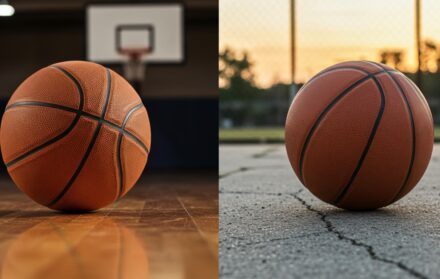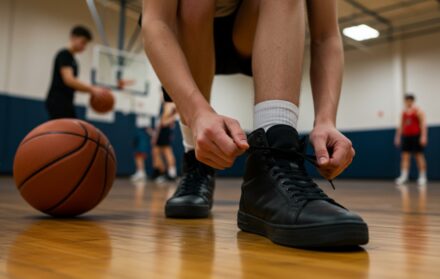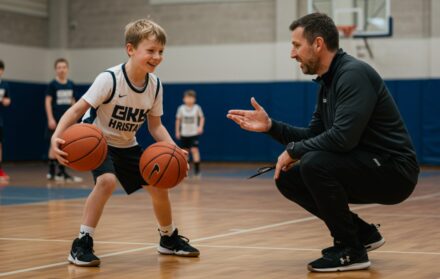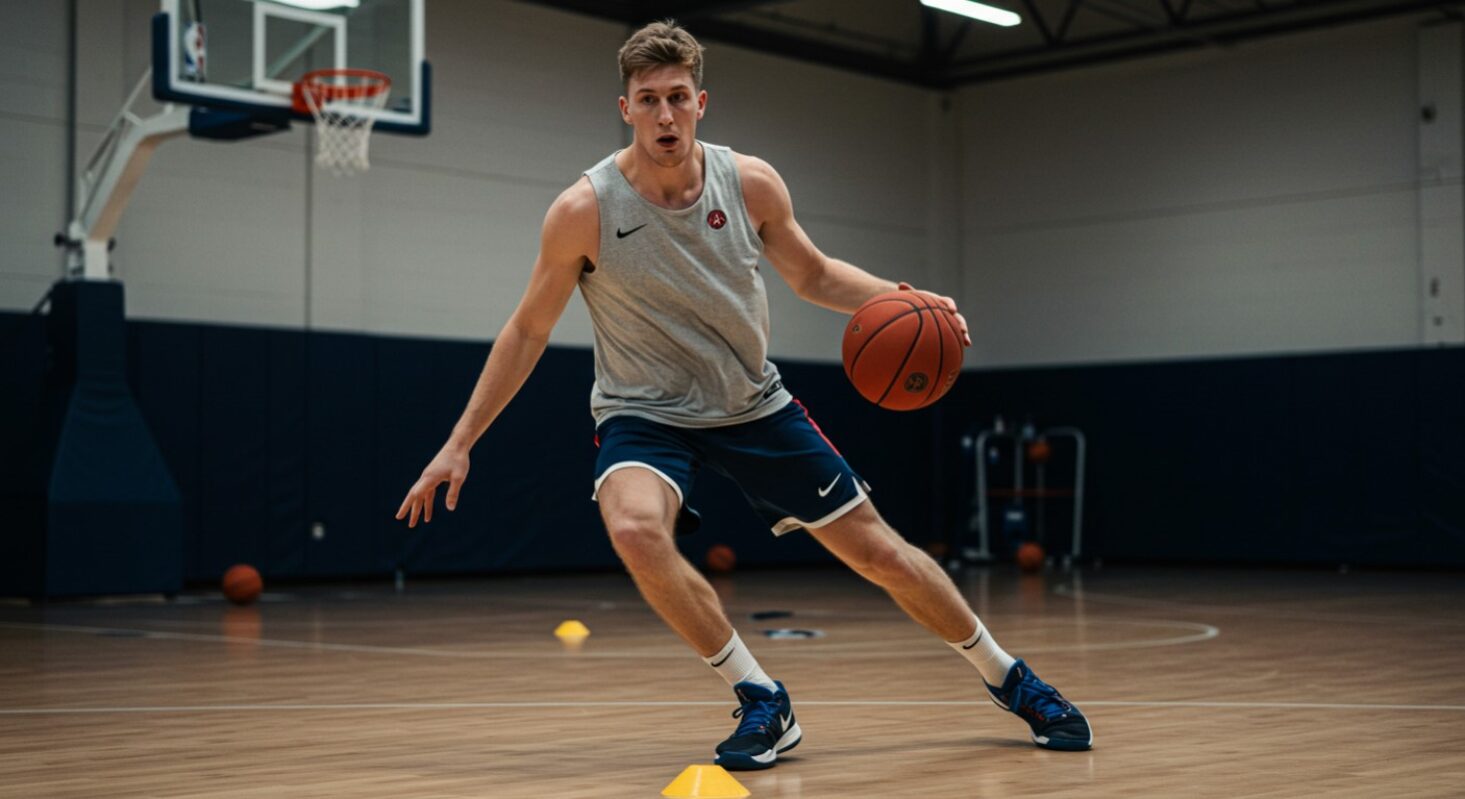
29 Essential Basketball Training Drills for All Players
Great players are built in practice. Drills turn good habits into automatic actions so that under pressure, you make the right move without thinking. Even at the highest level, stars live on repetition: think of Steph Curry’s pre-game ball handling and shooting routine, or Kobe Bryant’s relentless footwork.
This guide gives you a complete, practical programme of the best basketball training drills across ball handling, passing, shooting, defence, rebounding, conditioning, and teamwork. For every drill you will get the purpose, set-up, step-by-step instructions, coaching cues, common mistakes, and clear progressions from beginner to advanced. You can copy the session templates at the end and start today.
Before you begin, warm up for 8 to 10 minutes: light jog, dynamic stretches, ankle and hip mobility, then 2 minutes of easy ball handling to wake up your hands. Make sure you’ve got the right basketball gear — shoes that grip, a properly sized ball, and clothing you can move in. And as you train, remember that every drill connects back to basketball rules, so the habits you build in practice will translate directly into real games.
Dribbling and Ball Handling Drills
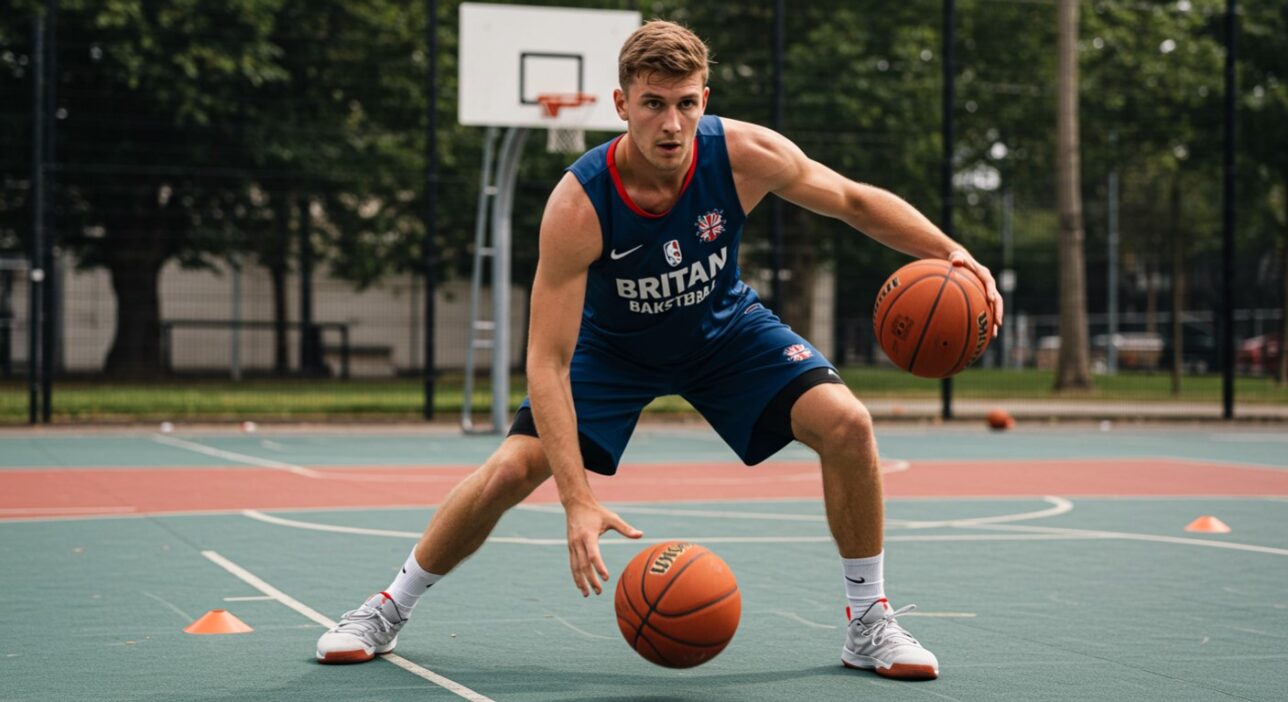
Purpose: Build control, confidence, and ambidexterity so you can keep the ball under pressure and create shots for yourself and others.
1) Stationary Dribbling Series
Set-up: One ball, 2 x 2 metres of space.
How to do it (beginner 30 to 45 seconds each, rest 15 seconds):
- Pound dribbles right hand waist height.
- Pound dribbles left hand waist height.
- Low pounds right hand, then left hand (below knee).
- High pounds right hand, then left hand (shoulder height, stay balanced).
- Front crossovers at waist height.
- Between-the-legs stationary.
- Behind-the-back stationary.
- Combo: cross, between, behind on a loop.
Coaching cues:
- Eyes up. Scan an imaginary court. Pick a point on the wall.
- Bend at hips and knees, back flat, off hand protects.
- Pound the ball into the floor. Snappy fingers, not slaps.
Common mistakes:
- Looking down at the ball.
- Hand too far under the ball, which becomes carrying.
- Standing tall. Tall body equals slow feet.
Progressions:
- Reduce stance height: try knee-level dribbles for control.
- Add a tennis ball in the non-dribbling hand. Toss and catch while you dribble.
- Add a metronome or timer. Increase rhythm from 120 bpm to 160 bpm over weeks.
- Alternate heights: one high, one low, switching every 2 dribbles.
Targets: Zero fumbles for the whole series. When you can go 3 rounds clean, speed up.
2) Cone Dribbling: Zig-zag Change of Direction
Set-up: 5 to 7 cones in a zig-zag across half a court, 3 to 4 metres apart.
How to do it (6 to 10 reps):
- Start at baseline. Attack the first cone at pace.
- At each cone, execute one move and explode to the next angle:
- Round 1: simple crossover.
- Round 2: in-and-out to crossover.
- Round 3: between-the-legs.
- Round 4: spin move.
- Finish at the rim with a layup or short pull-up.
- Jog back on the sideline for recovery.
Coaching cues:
- Lower your hips before the move. Change speed, not just direction.
- Push off the outside foot on the exit.
- After the move, take a long, powerful first step.
Common mistakes:
- Same speed throughout. No pace change means no separation.
- Dribbling too wide around cones instead of slicing by tightly.
- Looking down before the move, which telegraphs it.
Progressions:
- Time your run and aim to improve while staying under control.
- Add a live defender at the final cone to contest the finish.
- Add a second ball for advanced players: dribble one high and one low between cones, then finish with one ball.
Targets: Complete the course with one clean dribble move per cone and no extra steps sideways.
3) Two-Ball Dribbling
Set-up: Two balls, 2 x 3 metres of space.
How to do it (5 sets of 30 to 40 seconds):
- Same-time dribbles at waist height.
- Alternating rhythm dribbles.
- One high, one low, switch hands half-way.
- Crossovers with both balls together.
- Walk forward and back while keeping rhythm.
Coaching cues:
- Quiet feet, active hands.
- Keep both balls outside your feet to protect the dribble line.
- Maintain posture. Do not bounce up and down with the balls.
Common mistakes:
- Chasing the balls as they drift wide.
- Losing rhythm because the stance is too narrow.
Progressions:
- Add a quick 3 step shuffle left and right mid-set.
- Add a tennis ball toss while still dribbling both balls (advanced).
- Close your eyes for 5 seconds per set to test true feel.
Targets: 5 sets with zero drops. Then extend set length by 10 seconds.
4) Pressure Handling: 1-on-1 Containment
Set-up: Partner as light defender, half-court with a boundary box of cones.
How to do it (5 rounds of 30 to 45 seconds):
- Ball handler stays within the marked box while defender applies chest-to-ball pressure with hands legal.
- Handler must keep live dribble and beat to space, no wild retreats.
- Switch roles each round.
Coaching cues:
- Use changes of pace and body fakes more than flashy moves.
- Protect the ball with hips and off arm, but do not push.
- Escape with two hard dribbles then pick your head up.
Common mistakes:
- Turning your back and dribbling in circles.
- Picking up the ball too soon.
Progressions:
- Full-court 1-on-1 to the opposite baseline with time cap.
- Add a rule: two dribbles max before a pass to a coach or wall target.
- Add traps: a second defender steps in at a clap signal.
Targets: Complete rounds with fewer than 2 turnovers and at least one clean escape per round.
Passing Drills

Purpose: Improve accuracy, timing, and chemistry so the ball moves faster than the defence.
5) Wall Passing Accuracy
Set-up: Tape small targets on a wall at chest height and knee height. One ball.
How to do it (10 to 12 minutes):
- Chest pass to target, step into pass, 25 accurate hits.
- Bounce pass to lower target, 25 accurate hits.
- Overhead pass to high target, 20 accurate hits.
- One-hand push pass off the dribble from each hand, 20 each side.
Coaching cues:
- Step to the target. Thumbs snap down on release for backspin.
- Hit the same spot. Do not accept “near misses.”
- Keep passes flat and fast unless the situation calls for lob.
Common mistakes:
- No footwork. Flat feet lead to weak passes.
- Passes that drift off line or float.
Progressions:
- Add a quick pound dribble before each pass.
- Alternate targets rapidly to mimic reads.
- Perform sets while shuffling laterally.
Targets: 90 percent of passes hit the tape clean.
6) Partner Passing on the Move
Set-up: Two players, 8 to 10 metres apart.
How to do it (6 blocks of 1 minute):
- Jog and pass while moving toward and away from each other.
- Add bounce passes at full jog.
- Pass-and-cut: A passes to B, sprints for a return, catches, and finishes with 2 steps into a layup or floater. Reset.
Coaching cues:
- Lead the receiver into space.
- Call names and targets. Talk early: “Left,” “High,” “Bounce.”
- Catch with two hands, chin the ball, then move.
Common mistakes:
- Passing to where the player was, not where they are going.
- Lazy hands on catches.
Progressions:
- Add a defender shadowing the receiver at 50 percent effort.
- One-dribble limit before each pass.
- Add a read: coach flashes numbers 1 or 2, which tells you chest or bounce.
Targets: Zero dropped passes for a full block. Then increase speed.
7) 3-Man Weave
Set-up: Three players, full court.
How to do it (8 to 12 trips):
- Start with the ball in the middle, pass left, then run behind the receiver to fill the far lane.
- Catch, pass, and go behind continuously. No dribbles until the final layup.
- Finish with a layup, the shooter becomes the defender sprinting back to touch baseline, others rebound and go again.
Coaching cues:
- Pass early, then sprint behind wide.
- Hands up early to receive.
- Talk while you run.
Common mistakes:
- Drifting toward the middle and clogging lanes.
- Waiting too long to pass.
Progressions:
- Two balls. Start with balls on the wings, synch passes.
- Finish with a pull-up from the elbow on alternate trips.
- Add a chaser defender for pressure on the final pass.
Targets: Complete 8 trips without a drop. Then add pace.
8) Circle Passing
Set-up: 6 to 8 players form a circle, 2 balls opposite each other.
How to do it (5 minutes):
- Pass clockwise with verbal calls.
- On whistle, reverse direction instantly without dropping rhythm.
- Add a third ball when clean.
Coaching cues:
- Show targets with hands.
- Snap passes. No floaters across the circle.
- Communicate loudly.
Common mistakes:
- Ball watching and late hands.
- Soft passes that lead to drops.
Progressions:
- Add a defender roaming the middle trying to touch passes.
- Use bounce passes only for a round.
Targets: 60 seconds continuous without a drop. Add a ball if achieved.
Shooting Drills
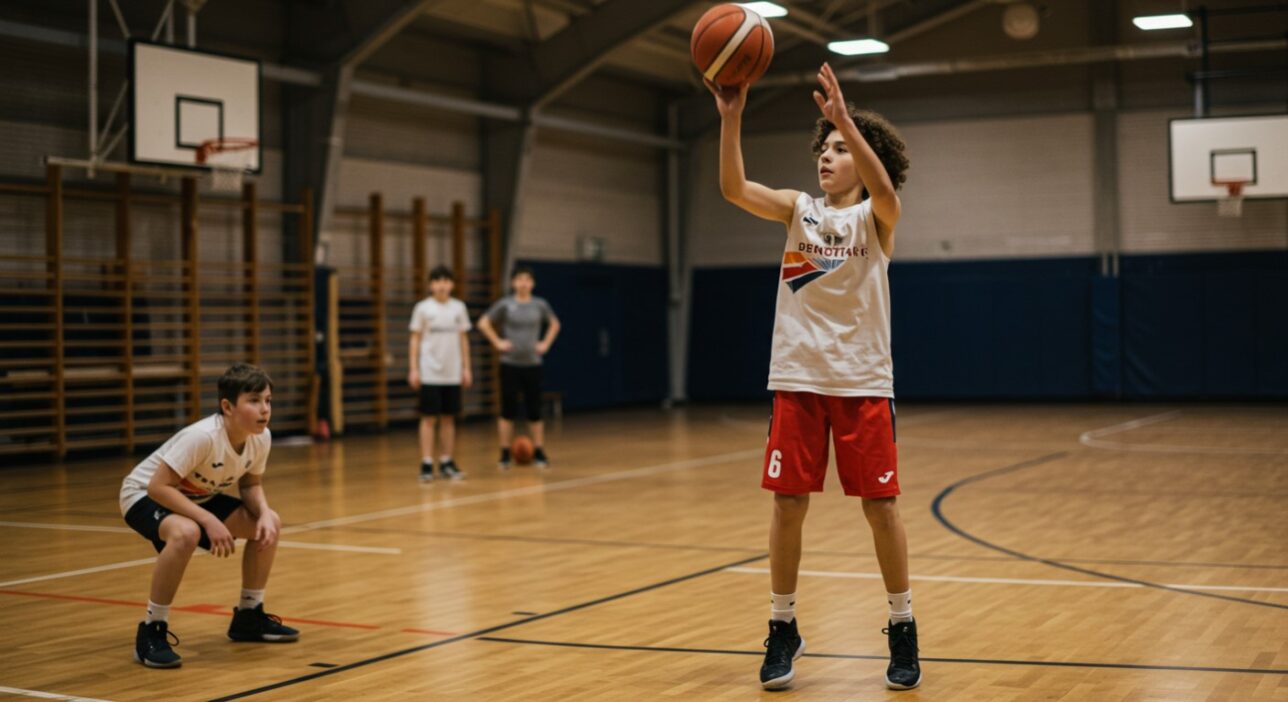
Purpose: Build mechanics, accuracy, speed, and confidence under game conditions.
9) Form Shooting Close Range
Set-up: One ball, one hoop, no more than 1 to 2 metres from the basket.
How to do it (25 makes x 2 angles):
- Feet shoulder width, shooting hand under centre of ball, guide hand on side.
- Shoot up through, hold follow-through, elbow to eye line, index finger to the rim.
- Swish or soft back-rim. Reset.
Coaching cues:
- One motion up, quiet lower body.
- Freeze the finish for one second.
- Eyes on the back of the rim.
Common mistakes:
- Reaching forward instead of lifting up.
- Guide hand pushing the ball.
Progressions:
- One leg balance shots to train stability.
- Alternate swishes only. Misses do not count.
- Close eyes on the hold for half a second to feel alignment.
Targets: 90 percent makes from close range before moving further out.
10) Spot Shooting: 5 Spots x 5
Set-up: Five spots around the arc or mid-range: corners, wings, top.
How to do it:
- Take 5 shots at each spot. Track makes.
- Round 1 catch-and-shoot, Round 2 one-dribble pull-up right, Round 3 one-dribble pull-up left.
Coaching cues:
- Show hands early, step to the pass.
- Land on two, then step into shot if needed.
- Same shot each time. Do not change form when you miss.
Common mistakes:
- Drifting sideways on the jump.
- Rushing before the feet are set.
Progressions:
- Add a closing defender with a hand up.
- Make it “make 7 to move” per spot for pressure.
- Use a shot clock on your phone for 0.8 to 1.0 second release.
Targets: 60 to 70 percent mid-range, 40 to 45 percent from three in workout conditions.
11) Catch-and-Shoot with Relocations
Set-up: One passer, one shooter, cones for relocations.
How to do it (8 to 10 minutes):
- Start in the corner, catch and shoot.
- Sprint to wing, hands out, catch and shoot.
- Sprint to top, catch and shoot.
- Continue around the arc. Focus on footwork: hop into shot or 1-2 step based on preference.
Coaching cues:
- Call for the ball. Ball in air, feet in air for a hop step.
- Show ten fingers, turn shoulders to the hoop early.
- Hold follow-through until the ball hits the rim.
Common mistakes:
- Lazy sprints between spots.
- Dropping hands late so the pass jams your chest.
Progressions:
- Add a drift relocation after drive-and-kick. Passer drives baseline, you drift along arc for vision.
- Add a punish rule: miss two in a row and you do 5 push-ups or quick footfire for 10 seconds.
Targets: 100 made threes in 15 to 20 minutes for advanced, 50 to 70 makes for intermediates.
12) Shooting Off the Dribble
Set-up: One ball, cones for starting points.
How to do it (8 to 12 minutes):
- From the wing, take two hard dribbles right into a pull-up at elbow.
- Repeat left. Alternate.
- Add side-step and step-back variations.
Coaching cues:
- Pound dribbles low, then rise into shot on balance.
- Stop on two feet for stability.
- Keep eyes at rim during the last dribble.
Common mistakes:
- Fading backwards on pull-up.
- Too many extra dribbles that kill rhythm.
Progressions:
- Add a trailing defender.
- Use 2 to 3 slide steps into a sidestep three.
- Set a 2 dribble max before every shot.
Targets: 60 percent mid-range makes, 35 to 40 percent off-dribble threes in practice.
13) Free Throw Routine
Set-up: Quiet focus, 20 to 50 attempts.
How to do it:
- Same footsteps to the line each time.
- Three breaths, one to three dribbles, set, shoot.
- Hold follow-through, eyes on the back rim.
Coaching cues:
- Build a ritual you can repeat under pressure.
- Exhale on the rise to relax shoulders.
Common mistakes:
- Changing routine mid-session.
- Rushing the first free throw when tired.
Progressions:
- Shoot pairs at the end of each drill while fatigued.
- Pressure game: must make 8 of 10 to leave the gym.
Targets: 80 percent in practice for guards and wings, 70 percent for bigs.
14) Game-Speed Shooting Under Fatigue
Set-up: One partner and a court lane.
How to do it (6 to 8 rounds):
- Sprint from baseline to half, back to the elbow.
- Catch from partner and shoot immediately.
- Rebound and repeat to the opposite elbow.
- 6 to 8 shots per round, rest 60 seconds.
Coaching cues:
- Control your breathing in the last 2 steps before shooting.
- Feet first, then hands, then eyes.
Common mistakes:
- Dragging feet and arriving off balance.
- Arm-only shots due to fatigue.
Progressions:
- Add a closeout from your partner.
- Make it 3 makes in a row to finish the round.
Targets: Keep accuracy within 10 percent of your fresh spot-shooting numbers.
Defensive Drills
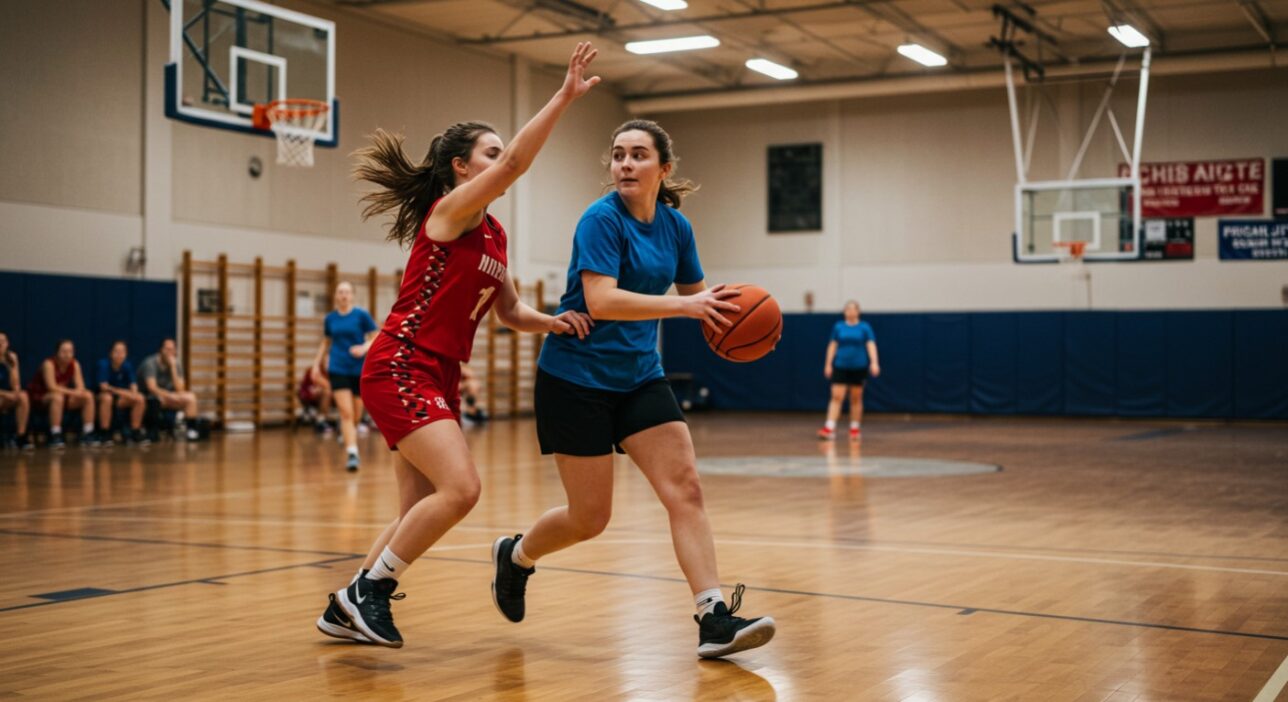
Purpose: Build footwork, positioning, and communication so you stop the ball without fouling.
15) Defensive Slides
Set-up: Two cones 6 to 8 metres apart.
How to do it (5 sets):
- Athletic stance, chest up, hands active.
- Slide from cone to cone, never crossing feet, touch line with outside hand, slide back.
- 20 to 30 seconds on, 30 to 45 seconds off.
Coaching cues:
- Push off your back foot, do not reach with the front.
- Hips low, head level, no bouncing.
- Short, sharp steps.
Common mistakes:
- Crossing feet or clicking heels together.
- Standing tall after two slides.
Progressions:
- Add a command from a coach to change direction at random.
- Hold a resistance band around the hips for partner resistance.
Targets: Maintain form and speed for the full set without rising.
16) Close-out Drill
Set-up: Player at the arc, coach or partner at the wing with a ball.
How to do it (8 to 12 reps each side):
- Start under the rim. On pass to the wing, sprint halfway, then chop steps with hands high.
- Arrive on balance, contest without fouling, then slide to contain the drive.
Coaching cues:
- One long sprint, then controlled short steps.
- Hand to the ball, other hand to chest to discourage shot and pass lanes.
- Stop short. Do not run into the shooter.
Common mistakes:
- Flying past the shooter.
- Arriving upright and getting blown by.
Progressions:
- Shooter becomes live: they either shoot or drive two dribbles.
- Add a second attacker for a 2 on 1 read off the close-out.
Targets: Contest cleanly and stop the first dribble penetration on 70 percent of reps.
17) Mirror Drill
Set-up: Two players face each other inside a 3 x 3 metre square.
How to do it (5 rounds of 30 to 40 seconds):
- Leader shuffles, jab steps, fakes. Mirror must stay chest to chest distance without touching.
- Switch leader and mirror each round.
Coaching cues:
- Eyes on the chest, not the ball.
- Quick first step on changes.
Common mistakes:
- Reaching at the hands.
- Hopping instead of sliding.
Progressions:
- Add a ball. Leader dribbles, mirror stays in front without fouling.
- Reduce the square size to increase difficulty.
Targets: Maintain the gap without collisions for the full interval.
18) Shell Drill: 4 on 4 Defence
Set-up: Four offensive players spaced at two corners and two wings, four defenders.
How to do it (8 to 10 minutes):
- Ball moves around the perimeter. Defenders jump to the ball line on every pass.
- Emphasise on-ball stance, deny one pass away, help two passes away.
- Call out “ball,” “deny,” “help.” Rotate positions every minute.
Coaching cues:
- See man and ball at all times. Head on a swivel.
- Short close-outs, early help, quick recoveries.
- Talk continuously.
Common mistakes:
- Ball watching then losing sight of your man.
- Late help that gives layups.
Progressions:
- Allow dribble penetration after 2 passes.
- Add a coach-controlled cutter or backdoor option.
Targets: Three stops in a row before switching sides.
Rebounding Drills
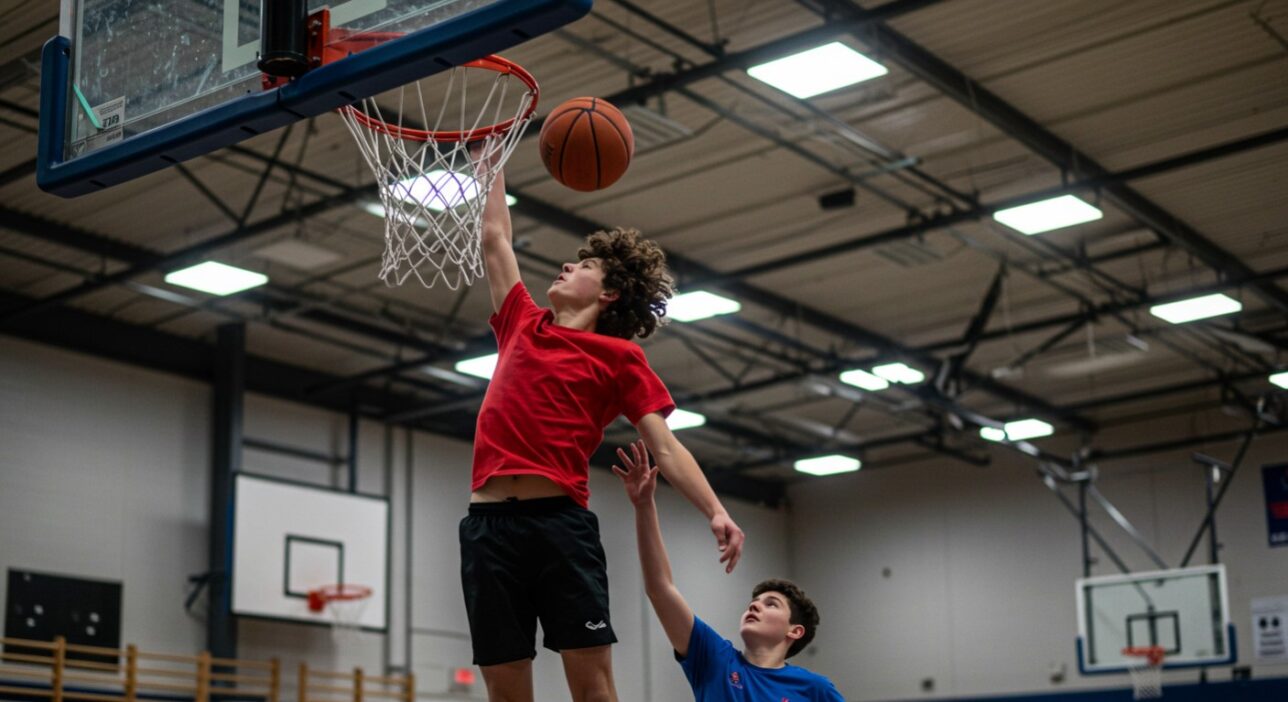
Purpose: Teach timing, contact, and the first pass of the fast break.
19) Box-out and Pursue
Set-up: Coach shoots from the free-throw line. Two players at opposite blocks.
How to do it (10 to 15 reps):
- On the shot, locate your man, make contact with a hip and forearm, turn and seal.
- Go get the ball at its highest point. Do not wait for it to fall.
- Chin the ball, use strong pivot, and outlet.
Coaching cues:
- Hit, find, get. Contact first, then turn to rebound.
- Two hands to the ball, land wide.
Common mistakes:
- Watching the flight then chasing late.
- Reaching over without sealing, leading to fouls.
Progressions:
- Add a third player to crash from the wing.
- Use a medicine ball for the outlet to build strength.
Targets: Secure 70 percent of live rebounds in the drill.
20) Triangle Rebounding
Set-up: Three players form a triangle near the lane. Coach tosses the ball off the rim.
How to do it (winner stays, 90 seconds blocks):
- On toss, all three box out and fight for position.
- Whoever rebounds must outlet to coach at the wing to score a point.
- Loser rotates out, new player rotates in.
Coaching cues:
- Anticipate long rebounds based on shot angle.
- Use your back and hips, not hands, to hold position.
Common mistakes:
- Jumping from too far under the rim.
- Bringing the ball down to waist level.
Progressions:
- Make it two-dribble limit after rebound to outlet.
- Add a quick put-back score option for 2 points instead of outlet.
Targets: 5 points to win the round.
21) Rebound and Outlet to Fast Break
Set-up: One rebounder under hoop, one outlet receiver near sideline hash, one finisher at half court.
How to do it (10 trips):
- Coach shoots. Rebounder secures, pivots, outlets to the wing.
- Receiver turns and throws a lead pass to the finisher for a layup.
- Rotate roles.
Coaching cues:
- Pivot away from pressure. Do not travel.
- Lead pass ahead of the run, not at the runner.
Common mistakes:
- Slow outlet that kills the break.
- Lead pass behind the runner.
Progressions:
- Add a trailing defender chasing the finisher.
- Add a second receiver for a two-lane break read.
Targets: 8 of 10 clean conversions.
Conditioning and Agility Drills
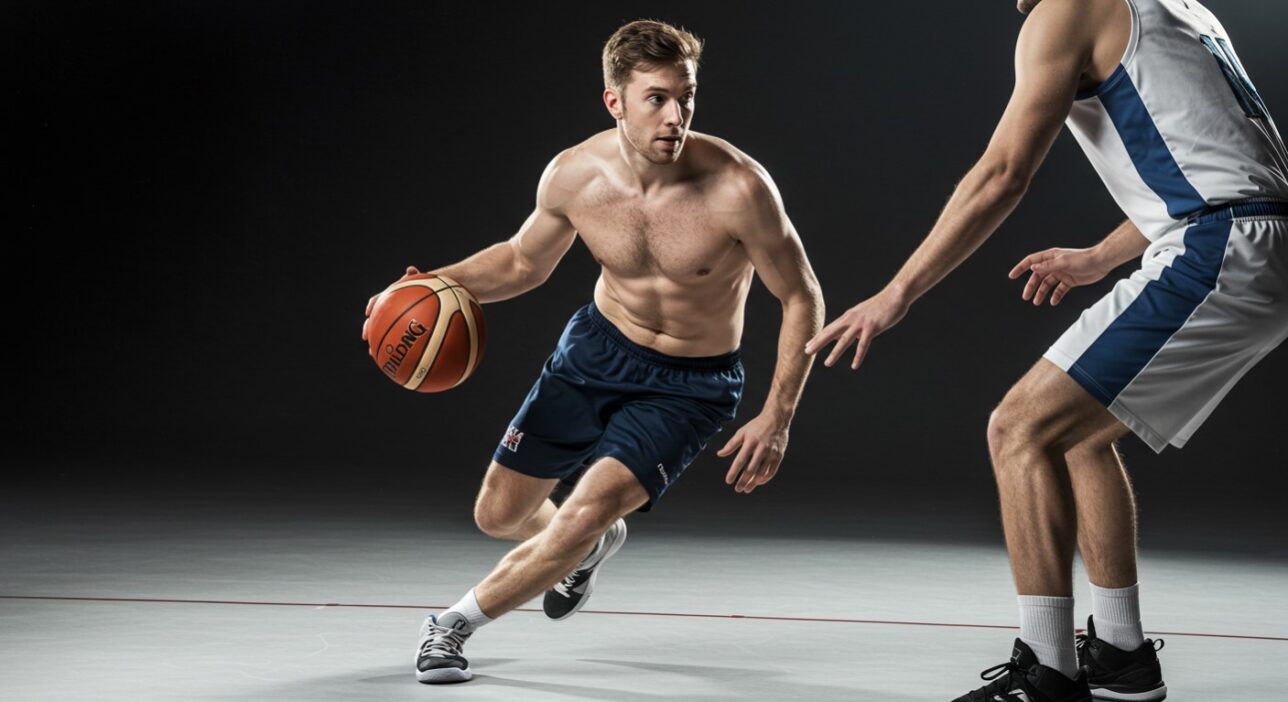
Purpose: Build speed, stamina, and bounce that carry your skills through a full game.
22) Suicides (Line Sprints)
Set-up: Full or half court lines.
How to do it (2 to 4 repetitions):
- From baseline, sprint to free-throw line and back.
- Sprint to half court and back.
- Sprint to far free-throw and back.
- Sprint to far baseline and back.
Coaching cues:
- Turn off the outside foot, stay low at lines.
- Even pacing. Do not explode then die.
Common mistakes:
- Standing tall at turns.
- Early fade that creates sloppy form.
Progressions:
- Add a ball. Dribble the whole suicide without losing control.
- Add a make to finish: after last touch, catch and shoot a free throw. Miss equals one extra rep.
Targets: Track time and aim to improve by small margins weekly.
23) Agility Ladder
Set-up: Ladder or tape on floor.
How to do it (6 to 8 patterns, 2 sets each):
- One foot in each.
- Two feet in each.
- In-in-out-out.
- Lateral in-and-outs.
- Ickey shuffle.
- Carioca steps.
Coaching cues:
- Quiet feet, no heel strikes.
- Pump arms like you run.
Common mistakes:
- Looking down constantly.
- Big jumps instead of quick steps.
Progressions:
- Hold a ball while moving.
- Toss and catch a tennis ball with a partner as you go.
Targets: No missed squares at speed.
24) Plyometric Jumps and Rebound Taps
Set-up: Box or sturdy platform, backboard for taps.
How to do it:
- Box jumps: 3 sets of 6. Land softly, step down.
- Depth jumps to stick: Step off, land, explode up, then stick landing.
- Rebound taps: Jump under the hoop and tap the ball off the glass 10 times without dropping it, land light between taps.
Coaching cues:
- Abs tight, knees track over toes.
- Land like a cat, not like a sack of bricks.
Common mistakes:
- Valgus knees collapsing inward.
- Excessive volume that risks shins and knees.
Progressions:
- Add a mini-band above knees for alignment.
- Add a volleyball net or broom handle to reach over.
Targets: Jump quality before jump height. If you lose form, stop.
25) Transition Reads: 2-on-1 and 3-on-2
Set-up: Two or three attackers vs one or two defenders.
How to do it (6 minutes):
- 2 on 1: Ball handler attacks defender’s outside shoulder, pass late to teammate for layup if defender commits. If defender stays in the middle, finish strong.
- 3 on 2: Wings wide, middle pushes. First pass forces one defender to commit, second pass punishes.
Coaching cues:
- Pass fakes to move the lone defender.
- Keep the ball in the middle until a defender commits.
Common mistakes:
- Passing too early before forcing a decision.
- Charging into the defender instead of changing pace.
Progressions:
- Add back-pressure defender sprinting from behind.
- Add a rule: must finish with one pass or less for speed.
Targets: 70 percent conversion rate on advantages.
Teamwork and Communication Drills
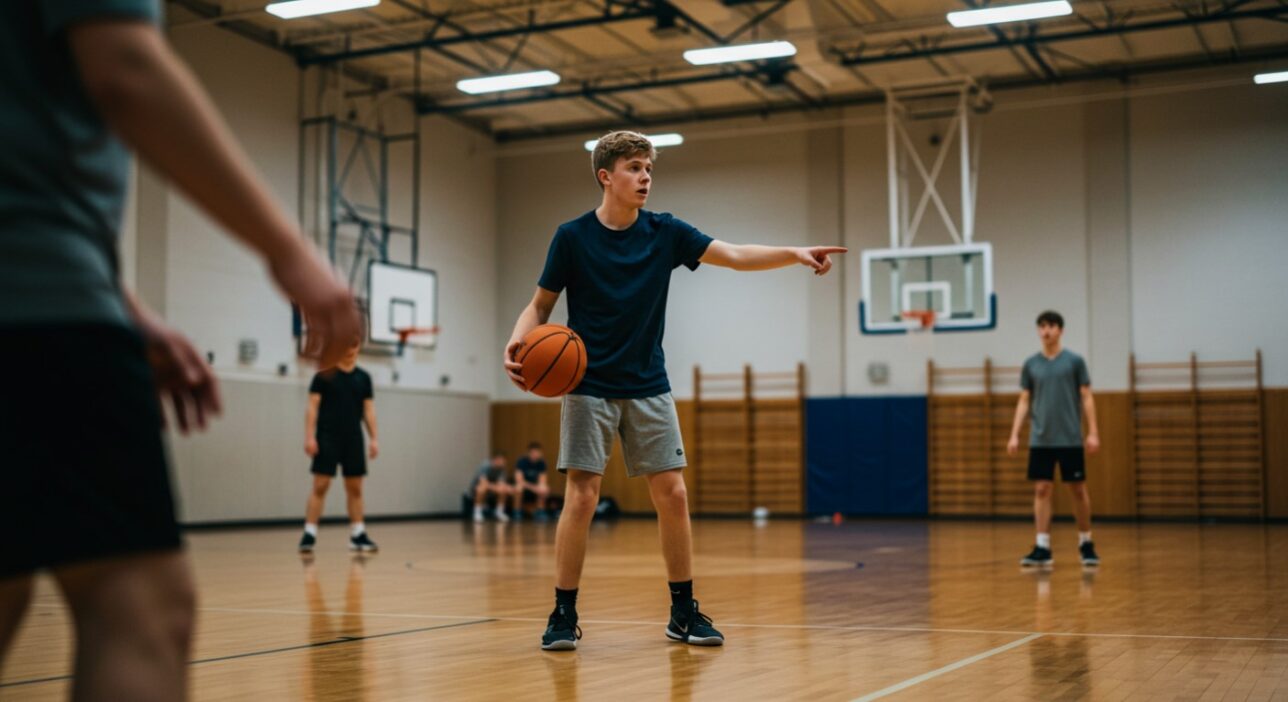
Purpose: Build shared timing and language that makes five players look like one.
26) 5-Man Fast Break Drill
Set-up: Five players, two lines on each sideline, one rebounder.
How to do it (8 to 12 trips):
- Rebounder outlets to the nearest guard.
- Wings run wide, centre runs rim to rim.
- Ball advances with two passes and a layup. Everyone touches the ball at least once by design variation.
- Next trip goes back the other way.
Coaching cues:
- First three steps are a sprint.
- Pass ahead when the pass is faster than your dribble.
- Communicate lanes out loud.
Common mistakes:
- Two players filling the same lane.
- Dribbling into traffic instead of advancing by pass.
Progressions:
- Add a trailer three as the last touch.
- Add two defenders to create semi-transition reads.
Targets: 10 clean makes in a row without a dropped pass.
27) Screen-and-Roll Progression
Set-up: Ball handler and screener, one defender or coach to guide.
How to do it (10 minutes):
- Stationary reps: screener sprints in, sets feet shoulder width, hands tight, then opens to the rim. Ball handler uses the screen tight, shoulder to hip.
- Live reads: drop coverage equals pull-up or pocket pass. Switch equals reject or hit the slip. Hedge equals retreat dribble then hit rolling big.
Coaching cues:
- Screener arrives and is still at contact. No moving screens.
- Ball handler changes pace into the screen, two hard dribbles off the hip.
- Look at the rim after turning the corner. Threat creates help.
Common mistakes:
- Screener leaning into defender.
- Ball handler taking the screen wide and letting defender squeeze through.
Progressions:
- Add a weak side shooter to lift or drift as a kick-out option.
- Play 3 on 3 live from the action.
Targets: 70 percent of reps produce a high quality shot or paint touch.
28) Constraint Scrimmages
Set-up: Small-sided games with rules that force habits.
Variations (play 3 minutes each):
- No dribbles: pass and cut only.
- Every player must touch the ball before a shot.
- Only layups and paint shots count.
- 0.5 second rule: catch, decide, and act within half a second.
Coaching cues:
- Embrace the rule, do not fight it. The constraint teaches the habit.
- Talk constantly to create flow.
Common mistakes:
- Freezing with the ball under the 0.5 rule.
- Standing after passing. Always cut or screen.
Progressions:
- Layer constraints, for example no dribbles plus 0.5 second rule.
Targets: Reduce turnovers each round while keeping pace high.
29) Call-Out Communication Drill
Set-up: Half-court defence set, coach calls actions.
How to do it (5 minutes):
- Coach calls “screen left,” “switch,” “ice,” “help,” “cut,” or “shot.”
- Defence must echo the call loudly and execute the correct coverage.
Coaching cues:
- Early and loud. If you whisper, it does not count.
- Use names: “Tom left, switch, switch.”
Common mistakes:
- Late calls that come after contact.
- One player talking while others stay silent.
Progressions:
- Add live offence after the call.
- Punish missed or late calls with 5 quick push-ups.
Targets: Zero silent possessions in a 3 minute window.
Building a Personal Training Routine
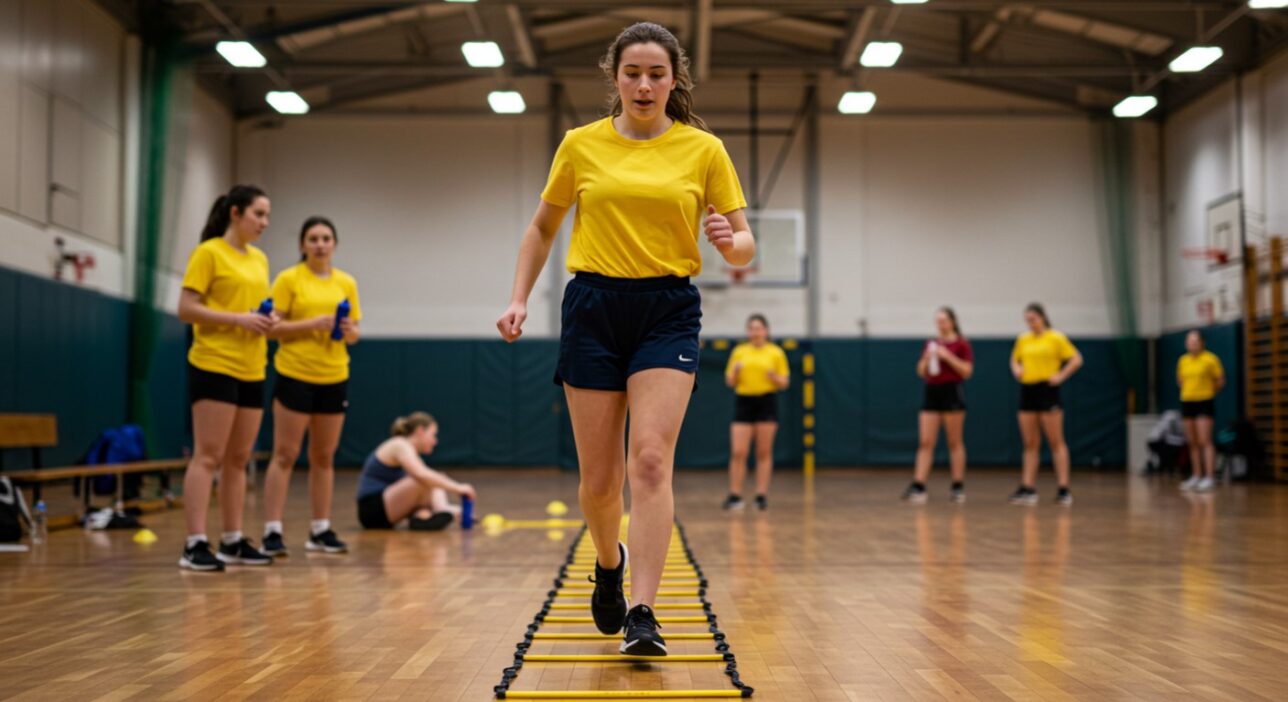
The best plan is the one you will follow. Here are three templates. Adjust volumes to match your fitness and court access.
Beginner 30 minute session
- Warm-up: 5 minutes.
- Stationary Dribbling Series: 6 minutes total.
- Cone Dribbling: 6 minutes.
- Form Shooting: 8 minutes to 30 makes.
- Free Throws: 10 attempts with routine.
- Defensive Slides: 3 x 20 seconds, rest 30 seconds.
- Cool down and log results: 2 minutes.
Weekly focus: 3 sessions per week. Aim to add one rep or one make each session.
Intermediate 60 minute session
- Warm-up and mobility: 8 minutes.
- Two-Ball Dribbling: 5 x 40 seconds on, 20 seconds off.
- Cone Dribbling with live finish: 10 reps.
- Wall Passing + Partner Passing on the move: 12 minutes total.
- Spot Shooting 5×5, then Catch-and-Shoot relocations: 120 total shots, record makes.
- Defensive Close-outs and Mirror Drill: 12 minutes.
- Suicides with the ball: 2 reps, time each.
- Free Throws under fatigue: 20 attempts in sets of 2 between drills.
- Cool down and log: 3 minutes.
Weekly focus: 4 sessions per week with one lighter day. Track shooting percentage by spot.
Advanced 90 minute session
- Warm-up including activation and plyometrics: 12 minutes.
- Pressure Handling 1-on-1 full court: 4 x 45 seconds each.
- Screen-and-Roll reads into 3 on 3 live: 15 minutes.
- Game-Speed Shooting under fatigue: 8 rounds, then Off-the-Dribble series: 60 to 100 shots.
- 5-Man Fast Break and 3-Man Weave with a chaser: 12 minutes.
- Shell Drill into constraint scrimmage blocks: 20 minutes.
- Triangle Rebounding and Rebound to Outlet: 12 minutes.
- Free Throws pressure test: make 8 of 10 to finish, or run 1 suicide and repeat.
- Cool down, mobility, and log: 6 minutes.
Weekly focus: 5 sessions, one focused on shooting volume, one on defence and rebounding, one on conditioning and transition, and two mixed.
Tracking Progress
- Log book: record date, drills, volumes, makes, and notes. Example: “5×5 spots, 69 of 125, right wing weak today.”
- Targets: choose 2 or 3 numbers to chase for 4 weeks, such as free throws at 80 percent, 3 man weave 10 clean trips, or cone zig-zag in 18 seconds clean.
- Video check: film one session per fortnight to review form on shooting and footwork.
- Turnover count: during pressure handling and constraint scrimmages, track turnovers. Aim to cut them by 20 percent in a month.
Common Mistakes Across Drills and How to Fix Them
- Going too fast too soon. Fix: slow down and master form for a week. Add speed only when you can complete sets cleanly.
- No clear purpose. Fix: write your purpose at the top of the session. Example: “quicker release from the wing” or “beat traps with two dribbles.”
- Too little rest or too much rest. Fix: use a timer. For skill work, work to rest about 1 to 1 at first, then 2 to 1 for conditioning blocks.
- Missing and moving on. Fix: if you miss the same shot twice in a row the same way, stop and fix a single cue. For example, set feet earlier or lift elbow.
- Silent sessions. Fix: bake in communication drills. In partner work, call names, spots, and coverages every rep.
Why Drills Work
Drills isolate a skill, give you hundreds of quality repetitions, and provide feedback. When you return to live play, your body does not need to search for the movement. It is already there. That is why even professionals keep shooting form close to the hoop every day, still run weave patterns, and still work on footwork under load.
Conclusion: Consistency Over Flash
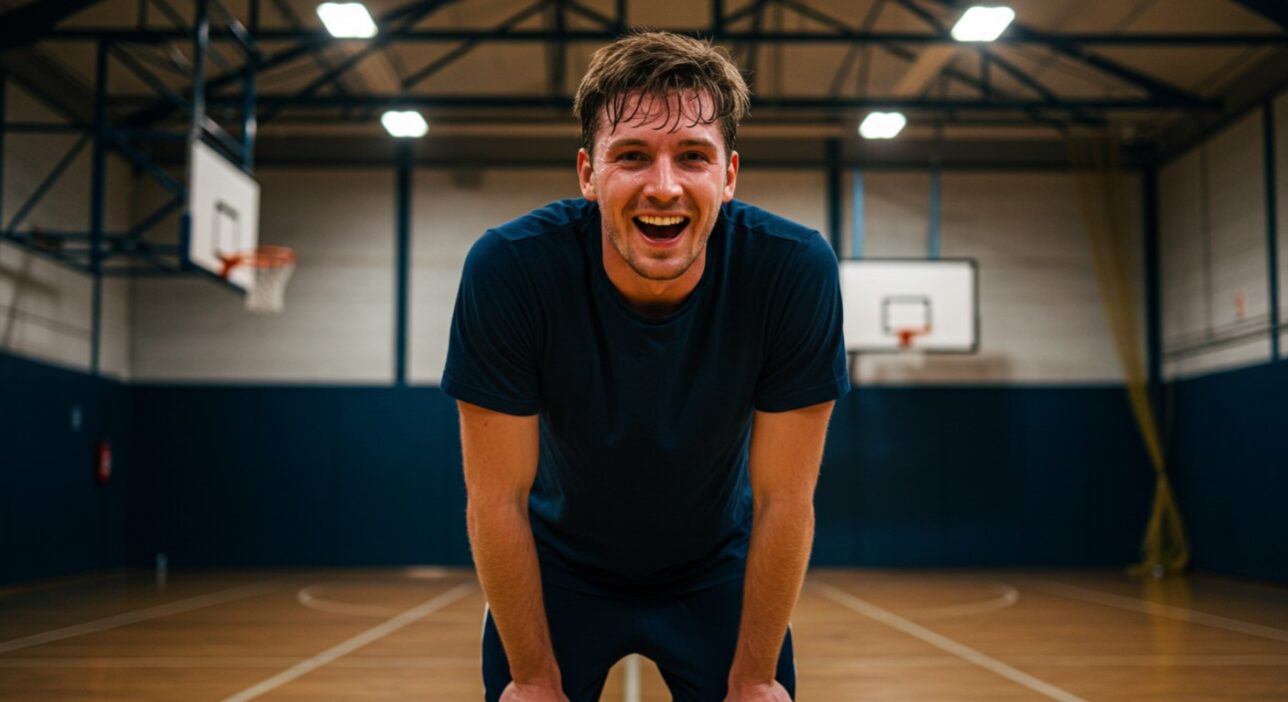
There is nothing glamorous about form shots from 1 metre or sliding between two cones. Yet that is what turns a casual player into a serious one. Choose a handful of drills from each section, run them with attention to detail, and track your numbers. In a month you will feel cleaner footwork, a steadier handle, sharper passes, and a jumper that holds up when your lungs are burning.
Start with the beginner session if you are new, move to the 60 minute plan once the basics feel automatic, and treat the 90 minute plan like a mini training camp once or twice a week. Stay patient, stay honest, and let the repetitions stack up. Your game will grow.

